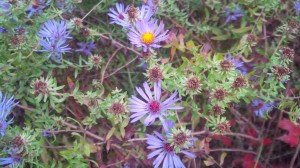I have always had a soft spot for alpine plants. Cold winds keep them short and tough. Thin soil forces their roots to reach deep into crevices to find water and nutrients. Short growing seasons mean that they must do their existential tasks—sprouting, flowering and setting seed—in a compressed time frame. All of that is hard work, yet so many of them find time to be beautiful. Humans, plants and animals that flourish at lower elevations should really bow down in respect.
A recent trip to Vail, Colorado, gave me a perfect opportunity to admire these small titans of the plant world. Vail is best known as a luxurious ski resort, but it is also home to the Betty Ford Alpine Garden, a horticultural jewel in a setting that includes imposing mountains and an endless blue sky. Even against that lofty background, the jewel shines.
Founded in 1985 by two Vail-based women, a landscape designer and an amateur gardener, the Ford Garden was christened in 1988. The Former President Gerald Ford and his wife, Betty, were regulars in Vail and their prominence helped increase the resort’s public profile. In addition to her interests in mental health and alcoholism treatment, Betty Ford had a gardening background. The founders thought that naming the garden in her honor and positioning it beside the Gerald R. Ford Amphitheater, created perfect synergy for the new enterprise.
The garden, which features multiple “rooms” and themed areas, is a multi-level tract, decked with rocks and water features that simulate the surrounding mountain environment. The plants are a mix of species that are either native to mountainous areas or can acclimate to the alpine environment. True alpines, which are plants that grow above the tree line, are there, as well as plants that flourish in mountain climates below the tree line. The plant collection is a mix of Colorado natives and species that grow in similar conditions elsewhere around the world. Some tough non-mountain perennials, like echinacea, descended from North American prairie plants, also ornament the perennial beds.
In any new garden environment, I look for plants that resemble familiar species from my home garden. Right now asters predominate at home. In Colorado, I saw the most beautiful mountain asters, which may have been Colorado tansyaster or Machaeranthera coloradoensis. The tansyasters bloomed vigorously in the gardens, but also turned patches of the surrounding mountains blue in their wild abundance. About as tall as New England asters, the Colorado blooms were the most amazing shade of azure blue. I don’t know whether it was the high altitude or light that accounted for the vivid color, but it was gorgeous.
I was lucky enough to see Parry’s gentian or Gentiana parryi, a low grower with chalice-like blooms in a deeper brilliant blue shade. These are very like the fringed gentians that I saw on a recent trip to High Point State Park in western New Jersey, but with blooms that open wide.
I missed the rarest of the blue flowers, the Himalayan blue poppy or Meconopsis betonicifolia, a hard to grow native of the Himalayas that has found a home at the Ford Gardens. To the uninitiated, it looks like many other poppies, except for the unusual blue color. It likes cool mountain conditions and would never grow in my New Jersey garden. This makes the blue poppy especially alluring when I see it elsewhere.
The various parts of the garden are accented and defined with water features, including pools, streams and waterfalls. The most prominent waterfall is the Alpine Rock Garden Waterfall, which cascades 40 feet, and provides a wonderful backdrop to a garden of South African plants. Here and there throughout the various garden spaces are troughs filled with small alpine plants, like members of the Saxifrage or rockfoil family. These flowering low growers are sometimes succulent, sprout from rock crevices and often form basal rosettes of leaves. They are native to mountain environments all over the world.
Vail is a fascinating place, constructed around a single theme and defined by a combination of high altitude and the high net worth of its denizens. There is absolutely nothing wrong with that, and much that is right, especially if you are a skier. However, I find the wonders of the Betty Ford Alpine Gardens to be an independent source of inspiration and the perfect complement to the more worldly charms of Vail.
